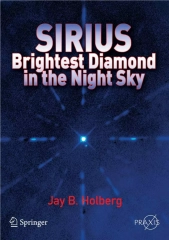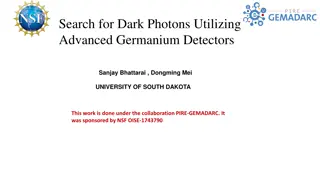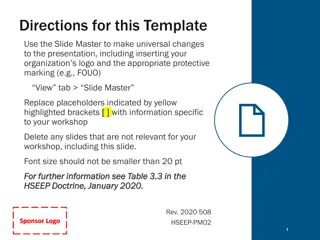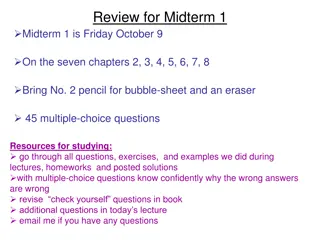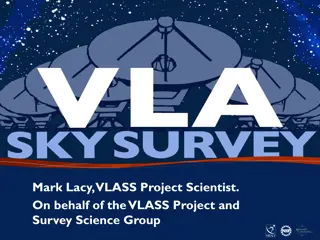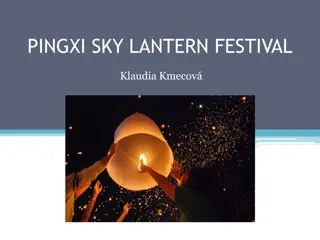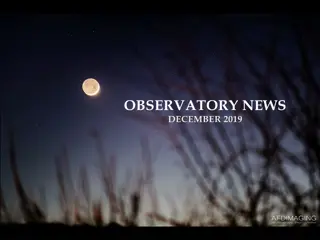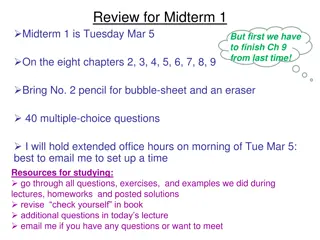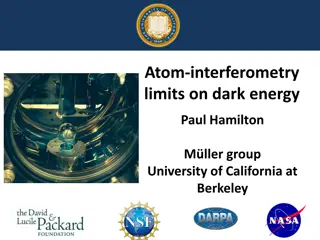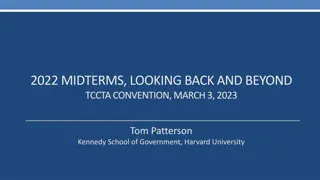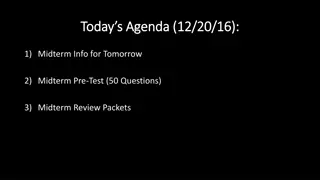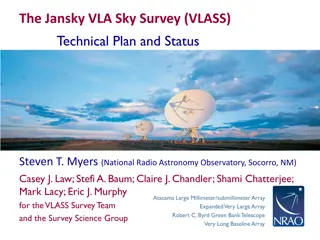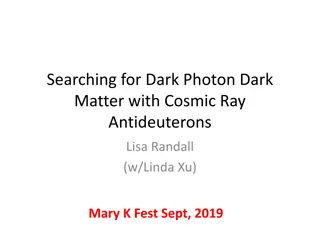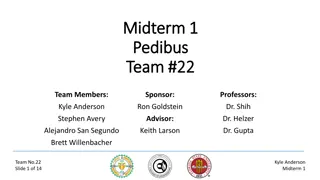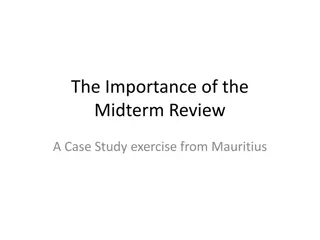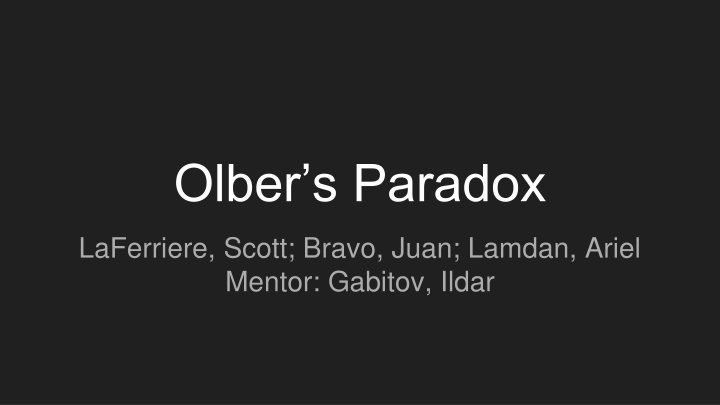
Unraveling the Enigmatic Olbers Paradox and Its Astronomical Implications
Delve into the intriguing Olbers Paradox, which questions the darkness of the night sky in a universe teeming with stars. Explore the historical background, interpretations by notable figures like Halley and Cheseaux, and the mathematical arguments that attempt to solve this captivating cosmic conundrum.
Download Presentation

Please find below an Image/Link to download the presentation.
The content on the website is provided AS IS for your information and personal use only. It may not be sold, licensed, or shared on other websites without obtaining consent from the author. If you encounter any issues during the download, it is possible that the publisher has removed the file from their server.
You are allowed to download the files provided on this website for personal or commercial use, subject to the condition that they are used lawfully. All files are the property of their respective owners.
The content on the website is provided AS IS for your information and personal use only. It may not be sold, licensed, or shared on other websites without obtaining consent from the author.
E N D
Presentation Transcript
Olbers Paradox LaFerriere, Scott; Bravo, Juan; Lamdan, Ariel Mentor: Gabitov, Ildar
The Paradox In the case that the universe is static and homogeneous, as well as populated by an infinite number of stars, any line of sight from the human eye should eventually intercept the surface of a star. Hence, the night sky should be completely illuminated.
Background/History Formulated by Thomas Digges in the 16th century and was discussed by mathematicians and astronomers throughout the 17th and 18th centuries First discussed in print in 1722 by Edmund Halley, whose solution involved apparent luminosity dropping by a factor of (1/r^4) Other solutions such as the redshifting of cosmic radiation and a finitely old universe have been postulated as well
An Interpretation Of the Paradox Assumption: Stars have a uniform distribution density in the universe Question: What happened to the missing starlight? Contributors under this assumption: Edmund Halley Jean-Phillipe Cheseaux Heinreich Olber
Halleys Argument Divide space into spherical concentric shells A shell of radius q has volume V=4 q^2 q, the volume of the shell increases by q^2 as q increases and so does the number of stars The light from each star in a shell decreases by 1/q^2 Since consecutive shells have q^2 as many stars with each star contributing 1/q^2 as much light, each shell contributes same amount of light
Cheseauxs Argument Dark spots in sky is simply starlight absorbed by interstellar medium Let D be the average distance between stars, V=D^3 (average volume occupied by single star Surface area of star: S= R^2 Then =V/S is the distance of background stars (mean free path of light from emission to absorption
Olbers Argument Applied both Halley s and Cheseaux s method a (Number of stars in a shell) = n*4 q^2dq, where n = 1/D^3 is stars per volume Fraction of sky covered by stars in a shell d = (number of stars)*(fraction of area each star takes up on surface area of sphere) = a * S/(4 q^2 ) = (S/D^3)dq=(1/ )dq By integrating d from 0 (observer) to radius q=r, we get = (r/ ) the fraction of sky covered by stars up to q=r Note that when r= , the sky should be completely cover by stars
Olbers Argument (continued) This must mean that any star where r> , must be obscured by the stars at r< Olbers applies Cheseaux by taking this occultation into account by including a factor of e^(-q/ ), d =e^(-q/ )*(1/ )dq. Now the fraction of sky cover by stars due to each shell is less as q increases With occultation taken into account and after integrating the new equation from q=0 to q =r, the fraction of sky covered by stars is =1-e^(-r/ ) Note =1 when r>>
Olbers Argument (continued) Much like taking occultation into account, just like Cheseaux, Olber took interstellar absorption into account by including a factor of e^(-q/ ), where is the absorption distance the d =e^(-q/ )*e^(-q/ )*(1/ )dq. After integrating as before, = /( + ) * ( 1 - e^( -r( + )/( ) ) ), fraction of sky cover from q=0 to q=r. Note for r >> ( )/( + ), = /( + ). In the case of an infinite universe the night sky is not completely covered
Another Interpretation Of the Paradox Assumption: The sky is not uniformly covered even in an infinite universe containing an infinite number of stars Question: What happened to the missing stars? Contributors under this assumption: John Herschel
Herschels Argument The dark gaps in the sky is due to lack of stars in that line sight, dark gaps are just empty space. That s IT! Herschel also proposed that if an interstellar medium absorbs light it would heat up and would emitted again (thus discounting the absorption factor taken into account by Chesaux and Olber)
Visible Universe Argument Assume the universe is unbounded, static and of finite age To the observer the visible universe is a radius of the age of the universe ,t, times the speed of light ,c. Stars that are not visible in the night sky are stars of light that simply have not reached us yet If <ct, the sky is covered by stars. If so, what happened to the missing starlight (this is first interpretation of paradox) If >ct, stars do not cover the sky. If so, what happened to the missing stars (this is the second interpretation)
Kelvins Approach Kelvin came up with an equation relating the energy density in space (u) to energy density on surface of a star (u*): u=u*(1-e^((-ct)/ )) If we divide by u* and set r=ct, we obtain the fraction of sky cover by stars = (u/u*) We can see from this equation, the night sky is covered by stars, =1, when the energy density in space equals the energy density on surface of stars, in other words when the visible universe is in thermodynamic equilibrium
Examining Previous Solutions Kepler: Concentric Shells (1610) - Only true when the universe is finite in size Olber: Dust Cloud (1823) - The dust cloud would begin to radiate. Bondi:Red Shift (1955) - Plausible solution! Only in the case of a steady state universe.
The Big Bang Solutions The Big Bang Solution is the most widely agreed upon plausible solution of Olbers Paradox. Galaxies beyond the hubble sphere exist outside the temporal boundary of our sight and cannot be observed. By the time light from distant galaxies reach us, the galaxies nearest us will grow cold and dark.
More Complicated Solutions? Spontaneous Formation of Universes from Vacuum via Information-induced Holograms There exist a number of plausible solutions to Olbers Paradox, one of the most interesting is that the formation of new universes accounts for the thermal disequilibrium first witnessed by Kepler, Olbers, and Bondi.
References Friedmann, Aleksandr. 125. On the Curvature of Space. A Source Book in Astronomy and Astrophysics, 1900 1975, 1922, pp. 838 843., doi:10.4159/harvard.9780674366688.c134. Harrison, Edward. The Dark Night-Sky Riddle, Olbers's Paradox. Symposium - International Astronomical Union, vol. 139, 1990, pp. 3 17., doi:10.1017/s0074180900240369. Frieden, B. R., & Gatenby, R. A. (2019). Spontaneous Formation of Universes from Vacuum via Information-induced Holograms. arXiv preprint arXiv:1909.11435.


